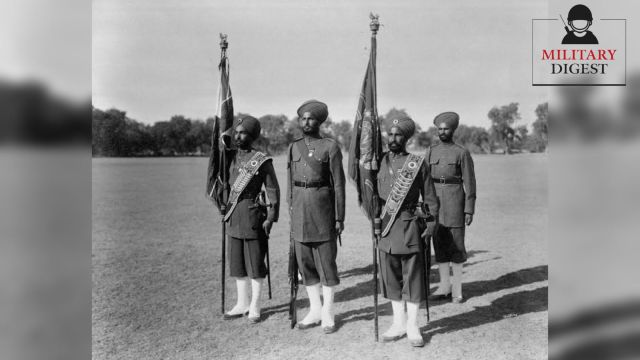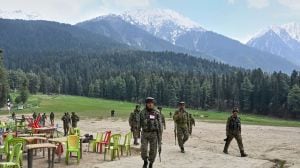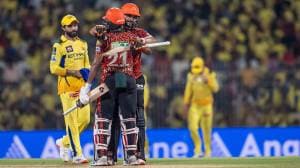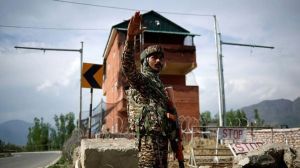Military Digest: A proud Regiment that faces an existential crisis
The Jat Sikh community, from which the Sikh Regiment draws its troops, is not coming forward in sufficient numbers.
 While the Sikh Regiment wasn’t a direct continuation of the Khalsa Army of Maharaja Ranjit Singh, it inherited the Sikh martial tradition, and many of its early soldiers likely had connections to the disbanded Khalsa forces. (Express Photo)
While the Sikh Regiment wasn’t a direct continuation of the Khalsa Army of Maharaja Ranjit Singh, it inherited the Sikh martial tradition, and many of its early soldiers likely had connections to the disbanded Khalsa forces. (Express Photo)Today marks Baisakhi. The day the Tenth Sikh Master Guru Gobind Singh created the Khalsa Panth. A day held very close to the hearts of the Sikh Regiment and Sikh troops of all regiments and Corps.
While the Sikh Regiment wasn’t a direct continuation of the Khalsa Army of Maharaja Ranjit Singh, it inherited the Sikh martial tradition, and many of its early soldiers likely had connections to the disbanded Khalsa forces. On this Baisakhi day, the Regiment is not in a happy state of affairs.
The Jat Sikh community, from which the regiment draws its troops, is not coming forward in sufficient numbers to join the Sikh Regiment. The causes are many, and as reported earlier by The Indian Express, the chief minister of Punjab, Bhagwant Mann, has associated this shortfall to migration abroad and the malaise of drug addiction afflicting the state. But that is only one side of the coin. The other side is apathy to the Agnipath scheme of recruitment and unwillingness to serve for only four years in the defence services as Agniveers.
Veteran officers of the Sikh Regiment say there is a shortfall of almost one company strength in the battalions of the regiment. Artillery regiments, which are pure Sikh in composition and class, are also said to be at almost 80-83 per cent of their total strength. These are not good portents. This might lead to a reduction in the number of battalions in the regiment or mixing the class, which will dilute the character and ethos of the regiment.
The development has prompted discussions about the regiment’s future and broader societal challenges in Punjab, a region historically known for its martial tradition and significant contributions to India’s armed forces.
Some express alarm, viewing the shortfall as a potential threat to the regiment’s legacy of valour, which includes 10 Victoria Crosses, 2 Param Vir Chakras, and numerous other gallantry awards. The regiment, traditionally recruiting Jat Sikhs for its enlisted ranks, relies heavily on Punjab’s youth, and migration – as per one estimate, over 4,78,000 Punjabis left between 2016 and 2021 – has noticeably thinned the pool of eligible candidates.
Drug abuse, affecting an alarming percentage of households in Punjab, further exacerbates the issue by rendering many unfit for military service. On platforms like X, sentiments reflect sadness and urgency, with users calling it a “national emergency” for Punjab and lamenting the decline of a proud tradition.
Others argue the issue is part of broader recruitment challenges across the Indian Army, particularly with the Agnipath scheme, introduced in 2022, which some claim deters long-term commitment due to its short four-year service model. Critics of the scheme suggest it lacks the job security and prestige that once drew Sikh youth to the regiment, though supporters of Agnipath argue it modernises the forces and shouldn’t be solely blamed. There’s also mention of physical fitness standards slipping, not just for the Sikh Regiment but in open recruitment categories across Punjab, pointing to a generational shift in priorities.
On the flip side, some voices, including retired military officials, caution against over-dramatising the situation. They note that recruitment ebbs and flows, and efforts like coaching programs for over 10,000 Punjab youths are underway to address the shortfall.
The reaction also touches on deeper societal questions – why are Punjab’s youth turning away from a path once synonymous with honour? Migration reflects economic aspirations, but the drug crisis points to systemic failures in governance and community resilience. Meanwhile, the Army’s push for merit-based recruitment over regional quotas, as raised by Punjab leaders in the past, clashes with the regiment’s traditional structure, creating tension between fairness and heritage.
Ultimately, the shortfall isn’t just a military issue – it’s a call to address Punjab’s social and economic drift. Whether through policy tweaks like rethinking Agnipath or grassroots efforts to curb drugs and boost fitness, the response will shape not just the Sikh Regiment but Punjab’s role as India’s “sword arm”.
The well-known Punjabi poet of the 19th century, Shah Muhammad, once lamented about Maharaja Ranjit Singh after the defeat of Khalsa Army at the hands of the British armies.
“Aj hove sarkar taan mul paave,
Jehrriyan Khaalse ne teghan maariyan ni
Shah Mohammada, ik sarkar bajhon,
Faujaan jitt ke ant noon haariyan ni”
(If today there were He, the value of Khalsa would be realised,
Of those Khalsa who won victories,
O Shah Mohammad, without Him,
The armies that won were ultimately defeated)
Hopefully Punjabis will rise to the crisis and not allow any lament to be written for the Sikh Regiment.
Must Read
Buzzing Now


Apr 26: Latest News
- 01
- 02
- 03
- 04
- 05























